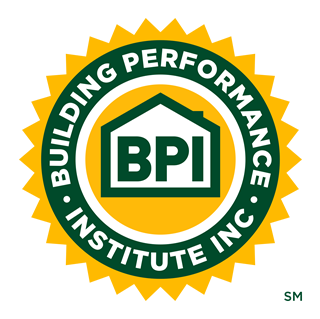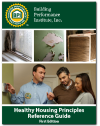
- Certificates
- Standards
- BPI GoldStar Contractors
- Test Centers
- Certified Professionals
- Primary
- Air Leakage Control Installer
- Building Analyst Technician (BA-T)
- Infiltration & Duct Leakage
- Core
- AC & Heat Pump
- Building Analyst
- Building Analyst Professional (BA-P)
- Envelope Professional
- Heating Professional
- Manufactured Housing
- Multifamily
- Multifamily Building Analyst
- Multifamily Building Operator
- Advanced
- Crew Leader
- Energy Auditor
- Healthy Home Evaluator
- Quality Control Inspector
- Retrofit Installer Technician
- Pilot
- EA/QCI 2025 Update
HHP Programs and Organizations
National Center for Healthy Housing
The NCHH is the preeminent national nonprofit dedicated to securing healthy homes for all. Since 1992, NCHH has served as a highly regarded and credible change agent, successfully integrating healthy housing advocacy, research, and capacity building under one roof to reduce health disparities nationwide. NCHH’s mission is to secure healthy homes for all. Through partnerships, community-based research, and advocacy, NCHH's initiatives focus on reducing health disparities by translating credible science into tools and catalyzing systems change in low-income communities.
Green & Healthy Homes Initiative
GHHI is a national nonprofit dedicated to breaking the link between unhealthy housing and unhealthy families. GHHI provides an innovative approach to addressing substandard housing by braiding together categorically separate but mission-related funding and programs, and by leveraging federal, state, local and philanthropic resources to create healthy, lead-safe and energy efficient homes across America. GHHI serves as the national model for green and healthy home interventions and is currently working in 25 cities and localities nationwide.
One Touch
One Touch is an e-referral program that connects health, energy, and home visit and repair programs to cost-effectively improve health outcomes and reduce home energy use. Government and non-profit partners that “touch” homes use a common home check-up tool and e-referral system to identify conditions triggering referrals or changes to the services delivered.
Children's Mercy Hospital of Kansas City
The Center for Environmental Health at Children’s Mercy Hospital is a nationally recognized program providing environmental health consulting, patient case management, research, education, training, and analytical services. Its team aims to help improve and advocate for the health of individuals with environmentally triggered illnesses. CMH's Healthy Home Program is a partnership between its staff, the patient's healthcare provider, and the patient and their family to help identify and reduce environmental exposures that may cause or worsen health problems. CMH's team assesses children's homes by performing a healthy home environmental assessment.
Rebuilding Together
Together with corporate and community partners, Rebuilding Together repairs homes, revitalizes communities, and rebuilds lives. Rebuilding Together’s local affiliates and nearly 100,000 volunteers complete about 10,000 rebuild projects nationwide each year.
Delos
As the pioneer of Wellness Real Estate™ and founder of the WELL Building Standard™, Delos is transforming homes, offices, schools, and other indoor environments by placing health and wellness at the center of design and construction decisions. The Delos platform includes technology, consulting, research, design, and innovative solutions for the built environment – creating spaces that nurture and promote human health and well-being.
For Health
For Health aims to improve the lives of all people in all buildings, everywhere, every day. They created the "9 Foundations of a Healthy Building" as a standardized, holistic approach to understanding how buildings impact the people inside them, using Health Performance Indicators (HPIs). By tracking HPIs on all 9 Foundations of the built environment, one can discover how to optimize buildings for health. For Health calls this "Buildingomics": the totality of factors in the built environment that influence human health, well-being, and productivity of people who work in those buildings.
Healthy Heating Educational Resource
Healthy Heating was established by Robert Bean in 2004 as a volunteer based not-for-profit educational resource serving as a technical interpreter and consolidator of academic research done between the building and health sciences.
HUD Office of Lead Hazard Control and Healthy Housing
The Healthy Homes Program at the U.S. Department of Housing and Urban Development (HUD) addresses multiple childhood diseases and injuries in the home. HUD's Healthy Homes Initiative (HHI) builds upon its successful Lead Hazard Control programs to address a variety of environmental health and safety concerns including mold, lead, allergens, asthma, carbon monoxide, home safety, pesticides, and radon. HUD's grants focus on researching and demonstrating low-cost, effective home hazard assessment and intervention methods, as well as on public education that stresses ways in which communities can mitigate housing-related hazards.
DOE Weatherization Assistance Program (WAP Plus Health)
The U.S. Department of Energy (DOE) Weatherization Assistance Program reduces energy costs for low-income households by increasing the energy efficiency of their homes, while ensuring their health and safety. The program supports 8,500 jobs and provides weatherization services to approximately 35,000 homes every year using DOE funds. Through weatherization improvements and upgrades, these households save on average $283 or more every year. Since the program began in 1976, WAP has helped improve the lives of more than 7 million families through weatherization services.
EPA Indoor Environments Division
The mission of the Indoor Environments Division at the U.S. Environmental Protection Agency (EPA) is to reduce public health risk for a range of indoor air pollutants, including radon, asthma triggers, mold, second-hand smoke, volatile organic compounds, particulate matter, and other IAQ pollutants. To accomplish this, IED conducts, research on indoor air quality exposures, health effects, and intervention approaches and technologies. IED uses this science to develop public information and action guidance to promote healthy indoor air strategies, policies, and interventions in homes, schools, and commercial buildings.
USDA Healthy Homes Initiative
The National Institute of Food and Agriculture (NIFA) within the U.S. Department of Agriculture (USDA) collaborates with HUD on the HHI to support research, education, and extension programs that increase home health and safety, improve family health, and build stronger communities.
Centers for Disease Control and Prevention
CDC's National Asthma Control Program (NACP) was created in 1999 to help the millions of people with asthma in the United States gain control over their disease. The program’s goals include reducing the number of deaths, hospitalizations, emergency department visits, school days or workdays missed, and limitations on activity due to asthma. Today, CDC funds the health departments in 24 states and Puerto Rico to ensure the availability of and access to guidelines-based medical management and pharmacotherapy for all people with asthma and to address the intersection of public health and health care through funding state programs and national organizations, promoting asthma quality measures, and informing policy makers about the burden of asthma.
Earn the Certificate
Get Started Now!Quick Links
 |
Discover the Connection Between Housing and Health
|

Suite 202 |
Saratoga Springs, NY 12866 |
(877) 274-1274
